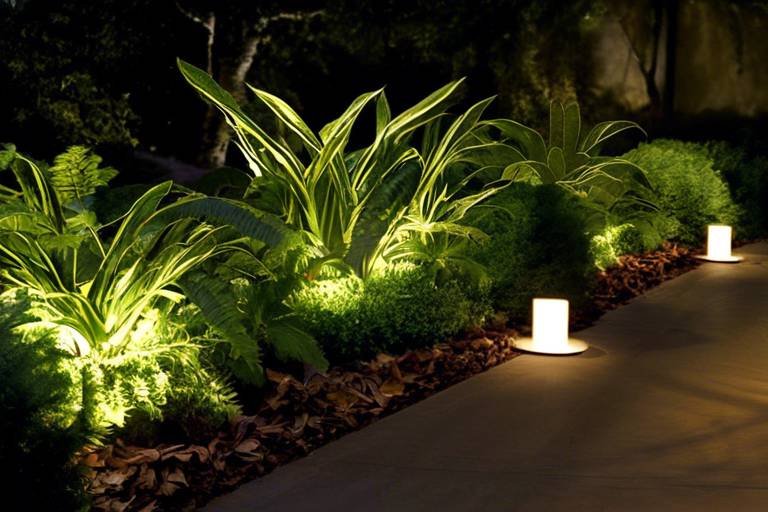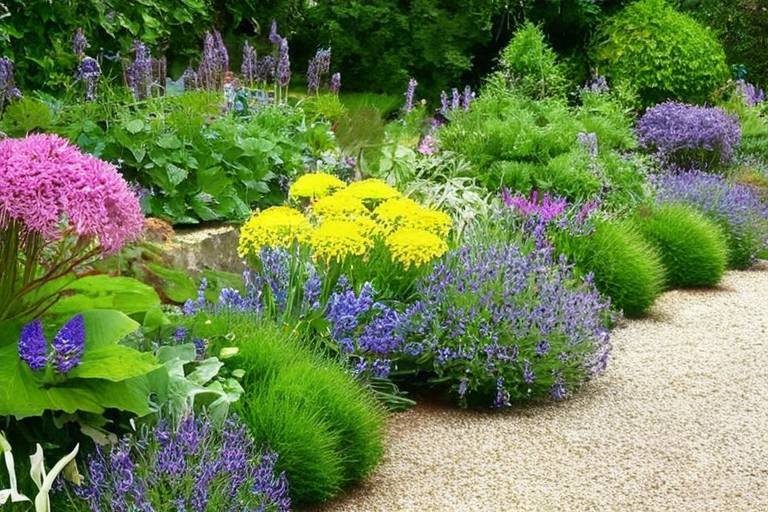Best Plants for a Dry, Rocky Garden
When it comes to creating a stunning garden in challenging conditions, the choice of plants plays a crucial role. In a dry, rocky garden where water retention is low and soil quality is poor, selecting the right plants is essential for ensuring both beauty and resilience. Let's explore some of the best plant options that not only survive but thrive in such harsh environments, requiring minimal maintenance while offering a burst of color and texture.
Succulents are the superheroes of dry, rocky gardens. With their fleshy leaves or stems that store water, these drought-tolerant plants are well-equipped to withstand the harshest conditions. Their ability to thrive in rocky soil makes them a perfect choice for adding both beauty and functionality to your garden. From the iconic Aloe Vera to the charming Echeveria, succulents come in a variety of shapes and sizes, offering endless possibilities for creative garden designs.
Wildflowers are nature's way of adding a pop of color to any landscape, and rocky gardens are no exception. Native wildflowers like yarrow and blanket flower not only bring vibrant hues to the garden but also attract essential pollinators like bees and butterflies. These hardy plants can thrive in rocky soil with minimal water requirements, making them a low-maintenance yet high-impact choice for your garden.
Herbs are not only a culinary delight but also a visual treat in rocky garden settings. Rosemary, thyme, and lavender are not just aromatic additions to your garden but also resilient plants that flourish in well-drained, rocky soil. These herbs offer a dual benefit by enhancing both the taste of your dishes and the aesthetic appeal of your garden, creating a sensory experience for anyone who visits.
Cacti, with their striking shapes and minimal care needs, are a must-have for any dry, rocky garden. Varieties like prickly pear and barrel cactus are not only resilient but also add a unique touch to the landscape. Their ability to thrive in arid conditions and rocky terrain makes them perfect for adding visual interest and texture to your garden without requiring constant attention.
Grasses may not be the first plants that come to mind for rocky gardens, but ornamental grasses like blue fescue and feather reed grass can work wonders in such environments. These grasses add movement and texture to the landscape, creating a dynamic visual appeal. Once established, they require minimal water, making them a practical choice for those looking to conserve water while maintaining a beautiful garden.
Shrubs are the backbone of any garden, providing structure and color to the overall landscape. In dry, rocky gardens, drought-resistant shrubs like Russian sage and juniper shine bright. These hardy plants not only survive in poor, rocky soils but also bring a touch of elegance and charm to the surroundings. Whether used as focal points or as borders, shrubs play a vital role in enhancing the beauty of your garden.
Perennials are the gift that keeps on giving in rocky, dry conditions. Plants like sedum and coneflower offer long-lasting blooms and adapt well to the challenging environment of a rocky garden. Their resilience and ability to thrive with minimal care make them ideal for those seeking a low-maintenance yet visually appealing garden. With a wide range of colors and shapes available, perennials can add a splash of vibrancy to your outdoor space.
Groundcovers are the unsung heroes of rocky gardens, providing a lush carpet that not only reduces erosion but also suppresses weeds. Creeping plants like creeping thyme and ice plant create a verdant cover over rocky terrain, adding a touch of greenery and softness to the harsh landscape. These low-growing plants not only fill in gaps between rocks but also create a cohesive look that ties the entire garden together.

Succulents
Exploring plant options that thrive in dry, rocky garden conditions, providing beauty and resilience with minimal maintenance requirements.
Succulents are a fantastic choice for dry, rocky gardens due to their remarkable ability to thrive in harsh conditions. These drought-tolerant plants have fleshy leaves or stems that store water, allowing them to withstand long periods without rain. Their unique appearance and low maintenance requirements make them a popular choice for gardeners looking to add both beauty and resilience to their outdoor spaces.
One of the key advantages of succulents is their adaptability to rocky soil. Their water-storing capabilities enable them to survive in environments where other plants may struggle. Additionally, succulents come in a wide variety of shapes, sizes, and colors, allowing you to create diverse and visually appealing arrangements in your rocky garden.
Popular succulent varieties for rocky gardens include the iconic aloe vera, the striking echeveria, and the charming sedum. These plants not only add visual interest but also require minimal upkeep, making them an ideal choice for busy gardeners or those looking to conserve water.
When planting succulents in a rocky garden, it's essential to ensure proper drainage to prevent waterlogging, as these plants are susceptible to root rot in overly moist conditions. By selecting a mix of different succulent species and arranging them strategically, you can create a stunning and sustainable garden that thrives in even the harshest of environments.

Wildflowers
Wildflowers are a delightful addition to any dry, rocky garden, bringing bursts of vibrant color and attracting essential pollinators. These native plants, such as yarrow and blanket flower, are well-suited to rocky soil conditions, thriving with minimal water requirements. The resilience of wildflowers allows them to flourish even in harsh environments, creating a beautiful and natural landscape.

Herbs
Rosemary, thyme, and lavender are popular that not only enhance the flavor of dishes but also bring a delightful aroma to your garden. These aromatic plants are well-suited for dry, rocky gardens due to their preference for well-drained soil. Rosemary, with its needle-like leaves, adds a touch of elegance and is known for its culinary versatility. Thyme, a low-growing herb, forms attractive mounds and releases a pleasant fragrance when brushed against. Lavender, prized for its fragrant purple flowers, not only attracts beneficial insects but also adds a pop of color to the rocky landscape.
These not only thrive in rocky, arid conditions but also require minimal maintenance once established. Their drought tolerance makes them perfect candidates for gardens with limited water access. Additionally, their resilience against harsh weather conditions ensures that they will continue to flourish even in challenging environments. Incorporating these into your garden not only adds visual interest but also provides you with fresh culinary ingredients at your fingertips.

Cacti
Cacti are remarkable plants that have adapted to thrive in arid and rocky environments, making them an excellent choice for dry garden landscapes. Their unique shapes and textures add a striking visual appeal to any garden setting. Cacti are known for their resilience and low-maintenance requirements, making them a popular choice for gardeners looking to add a touch of the desert to their outdoor space.
One of the key advantages of cacti is their ability to store water in their fleshy stems, allowing them to survive prolonged periods of drought. This makes them ideal for rocky gardens where water retention is crucial. Varieties such as prickly pear and barrel cactus are particularly well-suited to dry, rocky environments, requiring minimal watering once established.
In addition to their water-storing capabilities, cacti also come in a wide range of shapes, sizes, and colors, offering endless possibilities for creative garden design. Whether you prefer tall, columnar cacti or low-growing, clumping varieties, there is a cactus to suit every taste and space requirement.
When planting cacti in a rocky garden, it is essential to ensure proper drainage to prevent waterlogging, which can be detrimental to these drought-resistant plants. Incorporating gravel or sand into the soil can help improve drainage and mimic their natural desert habitat.
Overall, cacti are a fantastic choice for adding a touch of exotic beauty to dry, rocky gardens. Their unique features, low maintenance needs, and ability to thrive in harsh conditions make them a standout option for gardeners seeking both form and function in their outdoor spaces.

Grasses
Grasses play a vital role in adding movement and texture to dry, rocky gardens, enhancing the overall aesthetic appeal. Ornamental grasses, such as blue fescue and feather reed grass, are excellent choices for these challenging environments. Their wispy blades sway gracefully in the wind, creating a dynamic visual effect that mimics the gentle flow of water in an arid landscape. These grasses not only provide a sense of movement but also contribute to the garden's structure and balance.
Blue fescue, known for its striking blue-gray foliage, forms neat clumps that contrast beautifully with the rugged rocks in the garden. Its compact size makes it suitable for edging or mass planting, adding a touch of elegance to the rocky terrain. On the other hand, feather reed grass, with its tall, feathery plumes, adds vertical interest and a sense of drama to the landscape. Planted in clusters, it creates focal points that draw the eye and break up the monotony of the rocky backdrop.
When considering grasses for a dry, rocky garden, it is essential to choose varieties that are drought-tolerant and low-maintenance. These resilient plants can thrive in poor soil conditions, requiring minimal water once established. Their adaptability to harsh environments makes them ideal candidates for sustainable landscaping practices, reducing the need for frequent watering and upkeep.

Shrubs
When it comes to adding structure and color to a dry, rocky garden, shrubs play a vital role in creating a visually appealing landscape. Drought-resistant shrubs are particularly well-suited for rocky environments, as they can thrive in poor soil conditions and require minimal maintenance. Russian sage, with its silvery foliage and lavender-like flowers, is a popular choice for rocky landscapes, adding a touch of elegance and attracting pollinators.
Juniper, another resilient shrub variety, offers different textures and shades of green, creating depth in the garden design. Its needle-like foliage provides year-round interest, making it a versatile option for rocky garden settings. These shrubs not only contribute to the aesthetic appeal of the garden but also serve practical purposes by helping to stabilize the soil and reduce erosion.
By carefully selecting drought-resistant shrubs that are well-suited for rocky conditions, gardeners can create a low-maintenance landscape that thrives with minimal water and care. These shrubs can withstand the challenging environment of dry, rocky gardens, adding beauty and resilience to outdoor spaces while requiring little intervention from the gardener.

Perennials
When it comes to adding long-lasting beauty and adaptability to a dry, rocky garden, perennials are a top choice for gardeners seeking low-maintenance yet stunning plants. Perennial plants like sedum and coneflower are known for their resilience in harsh conditions, making them ideal for rocky landscapes. These plants offer a variety of colors, shapes, and sizes, adding visual interest to the garden throughout the seasons.
One of the key advantages of perennials is their ability to come back year after year, reducing the need for replanting and saving time and effort for gardeners. Sedum, also known as stonecrop, is a popular choice for rocky gardens due to its drought tolerance and attractive succulent foliage. Coneflowers, on the other hand, are prized for their vibrant daisy-like blooms that attract pollinators like bees and butterflies.
These perennial plants not only survive but thrive in dry, rocky conditions, requiring minimal water once established. Their deep root systems help them access moisture deep within the soil, making them well-suited for arid environments. Additionally, perennials like sedum and coneflower are easy to care for, needing little maintenance beyond occasional pruning and deadheading.
By incorporating a variety of perennials into your rocky garden, you can create a dynamic and ever-changing landscape that offers year-round interest. From the delicate blooms of coneflowers to the textured foliage of sedum, these plants bring diversity and resilience to rocky soil. Whether you're looking to attract pollinators, add pops of color, or simply enjoy the beauty of nature, perennials are a versatile and reliable choice for any dry, rocky garden.

Groundcovers
When it comes to covering rocky terrain with a touch of greenery, groundcovers play a vital role in creating a lush and vibrant garden landscape. These low-growing plants not only add beauty but also serve practical purposes like reducing erosion and suppressing weeds. Among the various options available, creeping thyme and ice plant stand out as excellent choices for groundcovers in dry, rocky gardens. Creeping thyme, with its aromatic foliage and delicate flowers, forms a dense mat that can withstand foot traffic, making it a perfect choice for pathways or between rocks. On the other hand, ice plant, with its succulent leaves and colorful blooms, not only adds visual interest but also helps in stabilizing the soil and preventing erosion on slopes. Both of these groundcovers require minimal maintenance once established, making them ideal for low-maintenance gardeners looking to enhance the beauty of their rocky landscapes.
Frequently Asked Questions
- What are the best plants for a dry, rocky garden?
In a dry, rocky garden, succulents, wildflowers, herbs, cacti, grasses, shrubs, perennials, and groundcovers are excellent choices. These plants are well-suited to thrive in harsh conditions with minimal water requirements, adding beauty and resilience to your garden.
- How can I ensure the plants in my dry, rocky garden survive and thrive?
To help your plants flourish in a dry, rocky garden, ensure proper soil drainage, provide occasional deep watering instead of frequent shallow watering, mulch to retain moisture, and select plants that are well-adapted to arid conditions. Additionally, regular monitoring for pests and diseases will help maintain the health of your garden.
- Are there any specific maintenance tasks required for plants in a dry, rocky garden?
Plants in a dry, rocky garden generally require minimal maintenance once established. However, occasional pruning to remove dead or damaged growth, fertilizing with a slow-release fertilizer in spring, and dividing overcrowded plants can help ensure the continued health and vitality of your garden.



















